Family name: Lamiaceae Martinov or Labitate Jussieu
Synonym(s): Aegiphilaceae Raf.; Chloanthaceae Hutch.; Dicrastylidaceae J. Drumm. ex Harv., nom. nud.; Labiatae Juss., nom. cons.; Menthaceae Burnett; Nepetaceae Bercht. & J. Presl; Salazariaceae F. A. Barkley; Scutellariaceae Döll; Symphoremataceae Wight; Viticaceae Juss.
Common name(s): mint family
*Number of genera/species: 256/7,530
List of genera records in GRIN-Global
Fruit indehiscent, usually schizocarpschizocarp:
fruit formed from a single ovary, with fused carpels, with or without accessory tissue; splitting between locules to form distinct, indehiscent, usually one seeded segments; usually dry, rarely fleshy (compare mericarp)
 , splitting into 2 or 4 nutlike mericarpsmericarp:
, splitting into 2 or 4 nutlike mericarpsmericarp:
a one-seeded section (carpel) of a schizocarp, as in Apiaceae fruits (compare schizocarp)
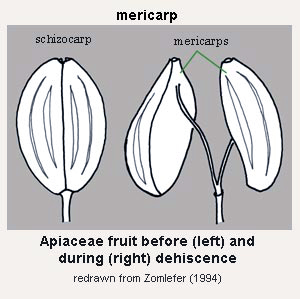 , sometimes drupelike (splitting into 4, 1-seeded pyrenespyrene:
, sometimes drupelike (splitting into 4, 1-seeded pyrenespyrene:
the hard inner portion of a drupe, consisting of a bony endocarp and an enclosed seed
, or 2 pyrenespyrene:
the hard inner portion of a drupe, consisting of a bony endocarp and an enclosed seed
, or not splitting), 0.5–45 mm long, globoseglobose:
3D shape—more or less spherical to tetrahedral, usually tereteterete:
to tetrahedral, usually tereteterete:
approximately circular in cross section; width and thickness approximately equal
 in transectiontransection:
in transectiontransection:
a cross section; representing a plane made by cutting across an organ at a right angle to its length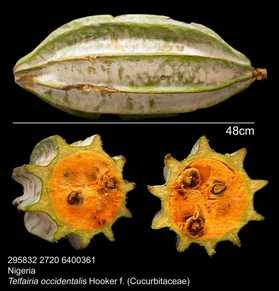 , stylestyle:
, stylestyle:
in a flower, the narrow and elongated part of the pistil between the stigma and the ovary; sometimes persisting in fruit
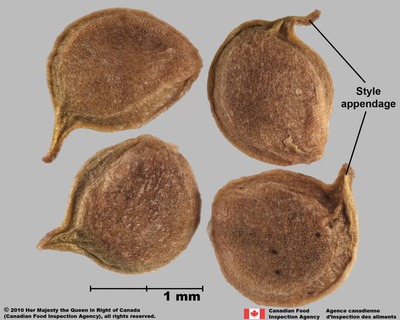 persistent, rarely beakedbeak:
persistent, rarely beakedbeak:
a usually firm, terminal appendage, sometimes tapered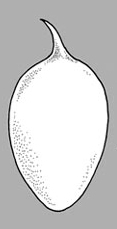 (Rostrinucula), rarely winged, 1-seeded, rarely 2 or 4 seeded, enclosed by persistent perianthperianth:
(Rostrinucula), rarely winged, 1-seeded, rarely 2 or 4 seeded, enclosed by persistent perianthperianth:
collective term for calyx and corolla of a flower
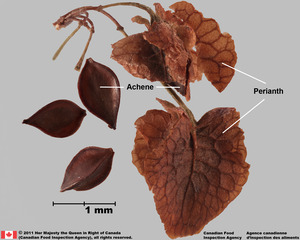 or calyxcalyx:
or calyxcalyx:
the outer whorl of the perianth; all the sepals of a flower
 . Pericarppericarp:
. Pericarppericarp:
fruit wall or fruit coat
black, brown (all shades), green, orange, red, yellow, rarely dark blue or white, dulldull:
reflecting only a low proportion of incident light, with no apparent sheen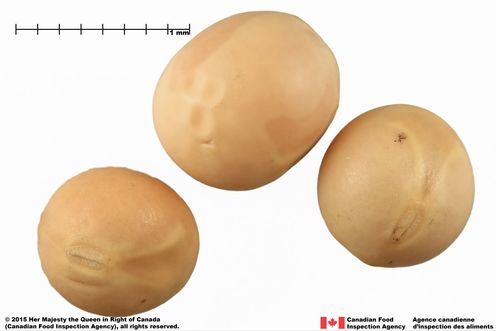 or shinyshiny:
or shinyshiny:
uniformly reflecting a high proportion of incident light at all angles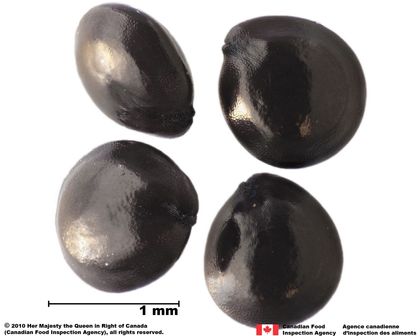 , hard or fleshyfleshy:
, hard or fleshyfleshy:
texture—fairly firm and dense, juicy or at least moist, and easily cut
, glabrousglabrous:
without hairs
or pubescentpubescent:
surface relief—bearing hairs
, may have glandularglandular:
surface relief—covered with small, raised secretory glands, regular or irregularly shaped, translucent or opaque, and maybe distinctly colored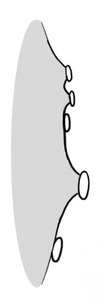 hairs or dots, often smooth or keeledkeel:
hairs or dots, often smooth or keeledkeel:
a longitudinal ridge, like the keel of a boat, formed by the lengthwise folding of a structure, such as a lemma or palea
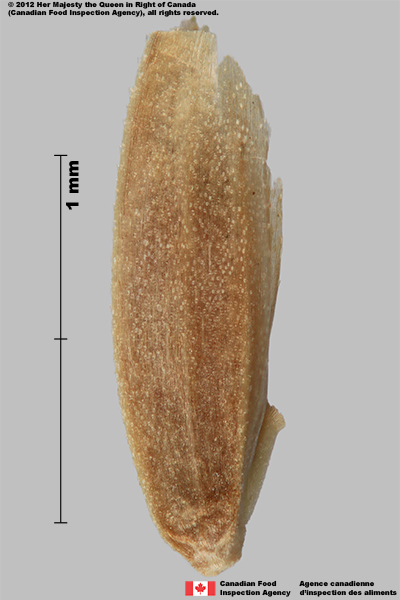 , sometimes ridgedridged:
, sometimes ridgedridged:
surface relief—raised, thick ridges, sharp edged or rounded, usually in a series that may cover the entire surface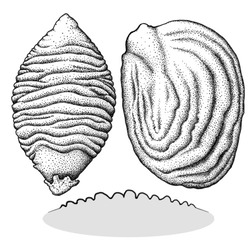 , pittedpitted:
, pittedpitted:
surface relief—surface with small depressions in which the areas between the hollows do not take on the appearance of a true reticular net , tuberculatetuberculate:
, tuberculatetuberculate:
surface relief—bearing small, warty, swelling, rounded, or variously shaped projections , papillatepapillate:
, papillatepapillate:
surface relief—bearing minute, distinct, broad-based projections, tapering to a rounded apex , reticulatereticulate:
, reticulatereticulate:
surface relief—netted, raised walls or concave grooves forming a net-like surface pattern with flat, concave, or convex interspaces , alveolatealveolate:
, alveolatealveolate:
surface relief—reticulated, honeycombed; ridges that intersect to form polygonal cells with a regular size and shape similar to a honeycomb , toothed or horned at apexapex:
, toothed or horned at apexapex:
the point farthest from the point of attachment, or the "tip" of an organ
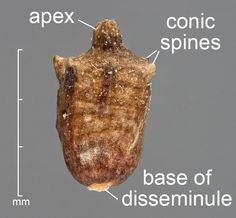 , sometimes mucilaginousmucilaginous:
, sometimes mucilaginousmucilaginous:
resembling mucilage; moist and sticky
. Elaiosomeelaiosome:
a lipid and protein-rich fleshy structure attached to some seeds and fruits, it attracts ants which then disperse the disseminule (e.g., caruncle in the Euphorbiaceae, the aril (outgrowth of the funiculus) in the Fabaceae)
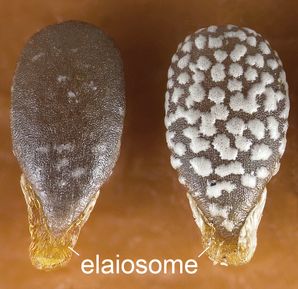 present in Lamium and Ajuga. Attachment scar usually visible, white, V-shaped or two eyelike slits, 1/4 to as long as nutletnutlet:
present in Lamium and Ajuga. Attachment scar usually visible, white, V-shaped or two eyelike slits, 1/4 to as long as nutletnutlet:
˜achene
.
Seed C-shaped C-shaped:
2D-shape—semiannulate, curved into the shape of the letter 'C'
or oblongoblong:
2D shape—much longer than broad with nearly parallel sides, corners are rounded , triangulartriangular:
, triangulartriangular:
2D shape—three relatively straight sides with distinct corners; more angular than teardrop-shaped or tereteterete:
or tereteterete:
approximately circular in cross section; width and thickness approximately equal
 , 0.5–40 mm long. Seed coat brown, dulldull:
, 0.5–40 mm long. Seed coat brown, dulldull:
reflecting only a low proportion of incident light, with no apparent sheen or shinyshiny:
or shinyshiny:
uniformly reflecting a high proportion of incident light at all angles , tight, glabrousglabrous:
, tight, glabrousglabrous:
without hairs
, sometimes with crease between cotyledons and hypocotyl-radicle.
Embryo well developed, completely to partially filling seed coat, axileaxile:
on or of the axis
and centric, foliatefoliate:
appearing leaf-like
, usually straight, rarely bentbent:
(of embryo) embryo is bent at an acute, V-shaped angle with the ends close together and generally thick cotyledons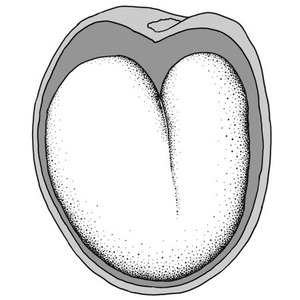 . Cotyledons investinginvesting:
. Cotyledons investinginvesting:
(of embryo) embryo is nearly or completely filling seed coat, straight, and axile and centric with spatulate cotyledons and covering the stalk for at least half its length; (of cotyledons) cotyledons spatulate and covering the stalk for at least half its length
or spatulatespatulate:
2D shape—like a spatula; rounded at the apex, with base long and tapered; (of embryo) embryo is straight and axile and centric with the cotyledons expanded to form the shape of a spatula or spoon; (of cotyledons) cotyledons expanded and wider than the stalk but not invested into the stalk .
.
Endosperm endosperm:
nutritive starch- and oil-containing tissue present in many seeds
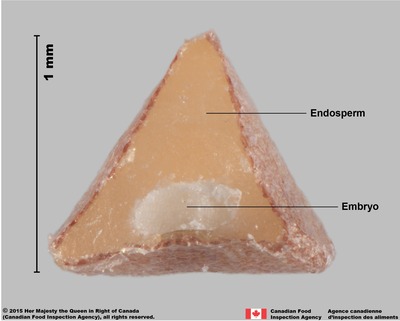 absent or scanty, if present fleshyfleshy:
absent or scanty, if present fleshyfleshy:
texture—fairly firm and dense, juicy or at least moist, and easily cut
and smooth.
| Fruit | |
| Type | schizocarp, dry or fleshyfleshy: texture—fairly firm and dense, juicy or at least moist, and easily cut , nutlike mericarpsmericarp: a one-seeded section (carpel) of a schizocarp, as in Apiaceae fruits (compare schizocarp)  or drupaceous or drupaceous |
| Size range | 0.5–45 mm long |
| Shape(s) | globose, ellipsoidellipsoid: 3D shape—elliptic , fusiformfusiform: spindle-shaped; broadest at the middle and tapering at both ends 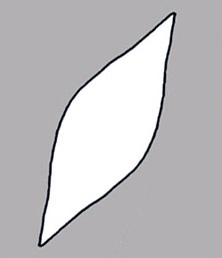 , oblongoblong: , oblongoblong:2D shape—much longer than broad with nearly parallel sides, corners are rounded  , claviformclaviform: , claviformclaviform:3D shape—club-shaped , obconicalobconical: 3D shape—inversely cone-shaped, with point of attachment at narrow end , boat-shaped, trigonoustrigonous: 3D shape—having three faces that meet at distinct angles; triangular in outline , tetrahedral, sometimes appearing lobed or deeply divided |
| Texture | hard, fleshy |
| Surface relief | smooth or keeledkeel: a longitudinal ridge, like the keel of a boat, formed by the lengthwise folding of a structure, such as a lemma or palea  , sometimes ridgedridged: , sometimes ridgedridged:surface relief—raised, thick ridges, sharp edged or rounded, usually in a series that may cover the entire surface  , pittedpitted: , pittedpitted:surface relief—surface with small depressions in which the areas between the hollows do not take on the appearance of a true reticular net  , tuberculatetuberculate: , tuberculatetuberculate:surface relief—bearing small, warty, swelling, rounded, or variously shaped projections  , papillatepapillate: , papillatepapillate:surface relief—bearing minute, distinct, broad-based projections, tapering to a rounded apex  , reticulatereticulate: , reticulatereticulate:surface relief—netted, raised walls or concave grooves forming a net-like surface pattern with flat, concave, or convex interspaces  , alveolatealveolate: , alveolatealveolate:surface relief—reticulated, honeycombed; ridges that intersect to form polygonal cells with a regular size and shape similar to a honeycomb  , toothed or horned at apex , toothed or horned at apex |
| Color(s) | black, brown (all shades), green, orange, red, yellow, rarely dark blue or white |
| Unique features | Usually brown or black, hard, 1-seeded nutlike mericarpsmericarp: a one-seeded section (carpel) of a schizocarp, as in Apiaceae fruits (compare schizocarp)  , often ridgedridged: , often ridgedridged:surface relief—raised, thick ridges, sharp edged or rounded, usually in a series that may cover the entire surface  or trigonoustrigonous: or trigonoustrigonous:3D shape—having three faces that meet at distinct angles; triangular in outline , with persistent stylesstyle: in a flower, the narrow and elongated part of the pistil between the stigma and the ovary; sometimes persisting in fruit  and visible attachment scar. Scar white, V-shaped or two eyelike slits, 1/4 to a long as nutletnutlet: and visible attachment scar. Scar white, V-shaped or two eyelike slits, 1/4 to a long as nutletnutlet:˜achene . Sometimes drupaceous with 1 or more pyrenespyrene: the hard inner portion of a drupe, consisting of a bony endocarp and an enclosed seed . |
| Seed | |
| Size range | less than 40 mm |
| Shape(s) | C-shaped, oblong |
| Color(s) | brown |
| Other | |
| Embryo | well developed, completely to partially filling seed coat, axileaxile: on or of the axis and centric, foliatefoliate: appearing leaf-like , usually straight, rarely bentbent: (of embryo) embryo is bent at an acute, V-shaped angle with the ends close together and generally thick cotyledons  . Cotyledons investinginvesting: . Cotyledons investinginvesting:(of embryo) embryo is nearly or completely filling seed coat, straight, and axile and centric with spatulate cotyledons and covering the stalk for at least half its length; (of cotyledons) cotyledons spatulate and covering the stalk for at least half its length or spatulatespatulate: 2D shape—like a spatula; rounded at the apex, with base long and tapered; (of embryo) embryo is straight and axile and centric with the cotyledons expanded to form the shape of a spatula or spoon; (of cotyledons) cotyledons expanded and wider than the stalk but not invested into the stalk  . . |
| Nutritive tissuenutritive tissue: tissue within the seeds that nourishes the developing embryo; such as endosperm, perisperm, or chalazosperm in angiosperms; megagametophyte in gymnosperms |
endosperm endosperm: nutritive starch- and oil-containing tissue present in many seeds  absent or scanty, if present fleshyfleshy: absent or scanty, if present fleshyfleshy:texture—fairly firm and dense, juicy or at least moist, and easily cut and smooth. |
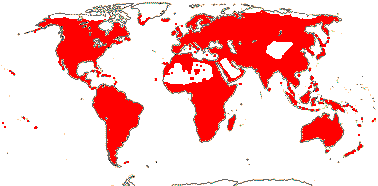
Distribution map courtesy of Angiosperm Phylogeny Website.
Bingham et al. 2021+; Flora of North America Editorial Committee 1993+; Keng 1978; Kirkbride et al. 2006; Kubitzki et al. 1990+; Mabberley and De Kok 2004; Paton et al. 2009; Takhtajan 2009; USDA 1980; Zhengyi et al. 2004+; Zhao et al. 2021
*The number of genera and species is based on Christenhusz and Byng 2016, which may differ from the number of genera in GRIN-Global.